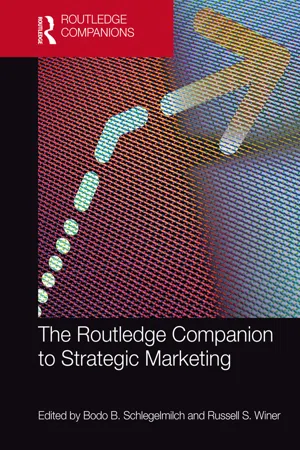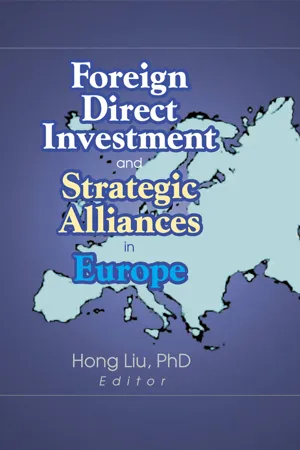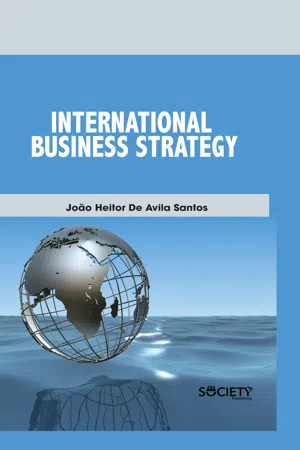Marketing
Market Entry Strategy
A market entry strategy refers to the plan and approach a company uses to enter a new market. It involves identifying target markets, understanding local regulations and consumer behavior, and determining the most effective way to introduce products or services. Market entry strategies can include methods such as exporting, licensing, joint ventures, or establishing wholly-owned subsidiaries.
Written by Perlego with AI-assistance
Related key terms
1 of 5
7 Key excerpts on "Market Entry Strategy"
- eBook - ePub
- Bodo B. Schlegelmilch, Russell S. Winer, Bodo B. Schlegelmilch, Russell S. Winer(Authors)
- 2020(Publication Date)
- Routledge(Publisher)
Alternative modes of market entry include internal development, acquisition, and joint venture/strategic alliance. Time of entry (e.g., one of the first-movers or an early entrant) may not be a strategic choice decision at the total discretion of a firm. However, in light of the associated advantages and disadvantages, firms may aspire and strive to have greater control over the decision. The vast body of literature in marketing on market entry through acquisitions and strategic alliances and on market pioneering/first-mover advantage highlights the importance of distinguishing between market strategy and marketing strategy. Marketing Strategy Definition: Marketing strategy is an organization’s crucial decisions concerning marketing activities to perform, their manner of performance, and the allocation of resources among markets and marketing activities to facilitate the achievement of a competitive advantage by an organizational entity in the marketplace. Marketing strategy is principally concerned with a business’s crucial marketing decisions concerning how to compete in the marketplace - eBook - ePub
Strategic Marketing
An Introduction
- Tony Proctor(Author)
- 2014(Publication Date)
- Routledge(Publisher)
Chapter 1Marketing strategy
Introduction and overviewINTRODUCTION
A strategy is a plan that integrates an organization's major goals, policies, decisions and sequences of action into a cohesive whole. It can apply at all levels in an organization and pertain to any of the functional areas of management. Thus there may be production, financial, marketing, personnel and corporate strategies, just to name a few. If we look specifically at marketing then there may be pricing, product, promotion, distribution, marketing research, sales, advertising, merchandising, etc. strategies. Strategy is concerned with effectiveness rather than efficiency and is the process of analysing the environment and designing the fit between the organization, its resources and objectives and the environment.The strategic process refers to the manner in which strategy is formulated. There are several approaches:■ the rational approach, making use of tools such as SWOT analysis and portfolio models■ the flexible approach, which employs multiple scenario planning■ the creative approach reflects the use of imagination in planning■ the behavioural approach reflects the influence of power, politics and personalities; and finally,■ the incremental approach is based on small adjustments or changes to previously successful strategies.Nohria et al . (2003) put forward an analysis of 160 successful USA companies in the period 1986 to 1996. They all outperformed their competitors in terms of strategy their implementation. This supremacy was founded on:■ clarity■ consistent communication to customers, employees and shareholders■ a value proposition relevant to targeted customers; and■ a realistic appreciation of the company capabilities.Marketing is about satisfying customer wants and needs and in the course of doing so facilitating the achievement of an organization's objectives. By paying attention to customer wants and needs, organizations are more likely to achieve their objectives in the market place. Of course, organizations have to compete with each other and so also have to satisfy customers' wants and needs at least as well as their competitors. Fortunately, organizations can do this in different ways. Competition involves finding a different way to satisfy customers from other organizations in the market place. In the pursuit of this end, products and services need to be seen as more than physical entities – it is the benefits they offer customers that are being purchased. - eBook - PDF
Navigating Strategic Decisions
The Power of Sound Analysis and Forecasting
- John E. Triantis(Author)
- 2013(Publication Date)
- Productivity Press(Publisher)
155 © 2010 Taylor & Francis Group, LLC New Market or Business Entry This chapter is an extension of the new product development (NPD) discussion and builds on and supplements those analyses and evaluations for new market or new business entry projects. Entry into a new market means starting operations in a new geographic area or market strata, with a reference point being the experience in the markets the company is currently operating. Entry into new busi-ness areas on the other hand entails sailing into unknown waters with no reliable reference points other than the decision maker’s, the forecaster’s, and the project team’s investigations, and their prior experiences. The former case requires an SDF solution that is highly intensive in its environmental assessment, while the latter entails that plus more in-depth understanding of trends and objective evaluation of internal competencies and capabilities in the context of the new company strategy. The focus of this chapter is on new market or business entry that is strategic in nature, which means they are long-term commitments that involve substantial financial and human resource investments. Under this criterion, entry into new parts of a country the company has a presence in, entry into a new market stratum, and market development are not part of this discussion. However, entry into a foreign market or new business is a major piece, and the underlying reasons for such projects include 1. Severe domestic market crowding and pressures, aging or outdated products, services, and technologies. 2. Preemptive competitive positioning to meet international customer needs, introducing new products, services, technologies, or ideas and testing their acceptance. Entry into a new similar business is undertaken to establish long-term market presence, or due to cost and portfolio management considerations. - eBook - PDF
- Mario Glowik(Author)
- 2016(Publication Date)
- De Gruyter Oldenbourg(Publisher)
The strategic decision process in the course of entering foreign markets is rela-tively complex, and the outcomes of foreign business normally have a vital impact on a firm ’ s destiny. In other words, the decision regarding the foreign entry mode strat-egy is one of the most critical for the management. Among others, it is usually costly to change the mode of entry once it is established due to its long-term consequences for the firm (Brouthers & Hennart, 2007: 396; Pedersen, Petersen, & Benito, 2002: 340). The choice of which foreign country to enter commits a firm to operating in a certain geographical and sociocultural terrain and signals its future strategic inten-tion to customers, suppliers, competitors, and other stakeholder (Ellis, 2000: 443). The portfolio of international market entry strategies can basically be distinguished among contractual forms (e. g., exports, franchising, original equipment manufactur-ing); cooperative partnerships, such as international joint ventures; and foreign direct investments (e. g., wholly owned subsidiaries). These strategies will be explained in detail in the following sections of the chapter. 132 3 Market Entry Strategies 3.2 Case Study: The Global Strategy Concept of Samsung 3.2.1 Samsung management philosophy – history and today The Korean economy is characterized by local-market-dominating Chaebols with highly centralized decision structures that consist of many affiliated companies. Compared to large Japanese conglomerates (Keiretsu), Chaebols are generally much younger. The oldest, Samsung, was established in Taegu in 1938 (Chen, 2004: 144) by Byung-Chull Lee (Samsung, 2007). Unlike Chaebols such as LG Elec-tronics, which was founded in 1947, Samsung ’ s origin goes back to the period of Jap-anese occupation of the Korean peninsula. - Hong Liu(Author)
- 2018(Publication Date)
- Routledge(Publisher)
Towards a Contingency View of Market Entry Strategies: Contextual and Strategic Factors Tamar AlmorSUMMARY. The model presented in this paper examines the relationship between contextual and strategic factors and foreign market entry strategies in the form of: (1) wholly-owned marketing subsidiaries, (2) international joint ventures, (3) international strategic alliances, (4) exports.Hypotheses are presented and tested on a sample of Israeli manufacturers who market their products in the European Union. Results show that each entry mode has a different contextual and strategic configuration, thus supporting the need for a contingency view. [Article copies available for a fee from The Haworth Document Delivery Service: 1-800-342-9678. E-mail address: <[email protected]> Website: < http://www.HaworthPress.com > © 2001 by The Haworth Press, Inc. All rights reserved.]KEYWORDS. Market entry strategies, FDI, international strategic alliances, international joint ventures, export, contingency view of entry modesIntroduction
Research regarding choice of market entry mode has largely focused on contextual variables such as country of origin and industry (e.g., Almor & Hirsch, 1995; Braunerhjelm & Oxelheim, 1992; Chang and Rosenzweig, 1998; Nitsch, Beamish and Makino, 1996; Oxelheim & Gärtner, 1996), size (e.g., Agarwal & Ramashwami, 1992; Buckley and Casson, 1976; Calof, 1994) and ownership (e.g., Argarwal and Ramaswami, 1992; Kogut and Singh, 1988). Other researchers have studied strategic variables in relation to market entry strategies such as a firm’s strategy, knowledge transfer and its perception of the competitive environment (e.g., Anderson and Gatignon, 1986; Calof & Beamish, 1995; Caves and Mehra, 1986; Gatignon and Anderson, 1988; Kim and Hwang, 1992; Kogut and Singh, 1988; Kogut and Zander, 1993). The various studies show that contextual as well as strategic variables are related to choice of market entry strategies.- eBook - PDF
- Joao Heitor De Avila Santos(Author)
- 2019(Publication Date)
- Society Publishing(Publisher)
INTERNATIONAL BUSINESS ENTRY STRATEGY CHAPTER 5 CONTENTS 5.0 Introduction ............................................................................................................ 66 5.1 Exporting International Market Entrance Strategy .................................................... 66 5.2 Contractual Agreement Entry Strategy ..................................................................... 72 5.3 Investment Entrance Strategy .................................................................................. 77 5.4 The International Market Entry Decision Process ..................................................... 79 References .................................................................................................................... 83 International Business Strategy 66 5.0 INTRODUCTION Politicians and government officials across the world affix greater wealth-production functions to a manufacturing plant (investment) than to a sales office. Thus, MNC’s exports to a country are usually tolerated in the trust that eventually the MNC will start producing the goods sold in the country locally. In the event, the MNC decides to take action, the internationalization process steps into the second phase, such as those licensing local manufacturers. Otherwise, the MNC might choose to co-produce with a local firm or to build a stock and then transform it into a wholly owned production plant. The internationalization process generally proceeds in a piecemeal fashion till MNC management identifies that building many small production plants worldwide is creating the MNC to reduce the economies of size potentially associated using its size. The MNC then commences an activity known as rationalization and in the United States nomenclature restructuring or globalization. This restructuring, which is the previous period in the internationalization process, can be an attempt to get back economies of level through better business and global management routines. - eBook - PDF
- Sharma, Premjit(Authors)
- 2021(Publication Date)
- Genetech(Publisher)
3 Market Entry Strategies Many agricultural products of a raw or commodity nature use agents, distributors or involve Government, whereas processed materials, whilst not excluding these, rely more heavily on more sophisticated forms of access. An organisation wishing to “go international” faces three major issues: i) Marketing—which countries, which segments, how to manage and implement marketing effort, how to enter—with intermediaries or directly, with what information? ii) Sourcing—whether to obtain products, make or buy? iii) Investment and control—joint venture, global partner, acquisition? Decisions in the marketing area focus on the value chain. The strategy or entry alternatives must ensure that the necessary value chain activities are performed and integrated. In making international marketing decisions on the marketing mix more attention to detail is required than in domestic marketing. Concerning investment and control, the question really is how far the company wishes to control its own fate. The degree of risk involved, attitudes and the ability to achieve objectives in the target markets are important facets in the decision on whether to license, joint venture or get involved in direct investment. Cunningham identified five strategies used by firms for entry into new foreign markets: i) Technical innovation strategy—perceived and demonstrable superior products ii) Product adaptation strategy—modifications to existing products iii) Availability and security strategy—overcome transport risks by countering perceived risks This ebook is exclusively for this university only. Cannot be resold/distributed. iv) Low price strategy—penetration price and, v) Total adaptation and conformity strategy—foreign producer gives a straight copy. In marketing products from less developed countries to developed countries point iii) poses major problems.
Index pages curate the most relevant extracts from our library of academic textbooks. They’ve been created using an in-house natural language model (NLM), each adding context and meaning to key research topics.






